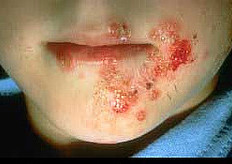Impetigo - treatment, causes and symptoms

Causes and Symptoms of Impetigo
Impetigo is a contagious bacterial INFECTION of the SKIN that most commonly affects young children. Staphylococcal or streptococcal BACTERIA are the usual culprits, typically taking advantage of breeches in the skin’s integrity that result from rashes, insect bites, and other minor wounds. The infection begins as small blisters, often around the MOUTH, that itch and burn. Scratching or touching the blisters and then touching other parts of the body spreads the infection. Contact also spreads the infection to other people. After two or three days the blisters rupture, ooze, and crust. The crust is characteristically honeylike in color and appearance. The blisters remain contagious as long as they are present.
Impetigo Treatment
Treatment is a topical antibiotic applied to the blistered areas. The doctor may also prescribe an oral antibiotic medication when the infection extends to multiple areas of the body. The blisters begin to recede within 24 to 48 hours of initiating treatment, which eases the itching and discomfort. The blisters are no longer contagious at this stage, and generally heal completely within five to seven days. Frequent HAND WASHING with antibacterial soap and warm water helps stop the spread of impetigo among children, family members, and caregivers. Prompt cleansing and treatment of minor skin irritations reduces the opportunity for impetigo to develop.
See also ANTIBIOTIC MEDICATIONS; BLISTER; RASH; TINEA INFECTIONS.